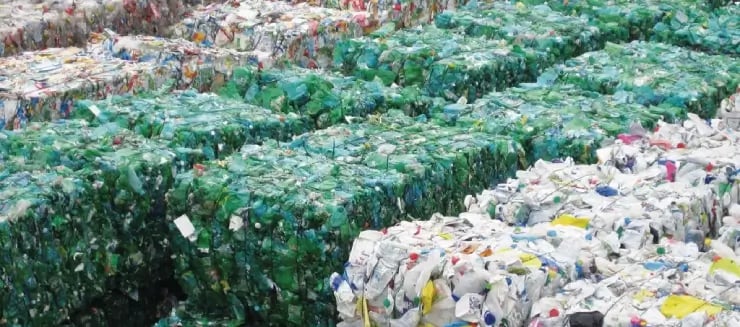Unlike the global north, most developing countries have difficulties affording sophisticated industrial machinery. Predictable economic conditions for their funding are just not easy to find. That’s why the waste management options I presented in last week’s article are not really much of an option outside the OECD. Even for some OECD members, they’re far from posing a realistic alternative to the status quo. But that doesn’t mean the hazard of small, disorganized garbage patches openly set on fire here and there has to prevail.
Different Waste Management Traditions
The “waste management” reality in most places of the world equals no separation, no controlled collection. Dump your stuff next to the street outside the village, like your ancestors always did, and you’re fine. When all the efforts to burn fail (which they usually do), cover the remaining pile with a thin layer of earth and ignore the horrible smell. The method has been around for centuries and it worked very well until recently: Self-sufficient agricultural societies traditionally took all their goods from nature. Because those goods were 100% biodegradable, nothing happened when they were dumped – they simply returned to nature. This is the tried and tested waste management system of the developing world. The problems began when 20th century inventions were injected into this system, inhibiting the cycle from continuing to function the way it used to. Plastic packaging, oil containers, tires, batteries, electronics – they all interfere with nature’s absorption capacity. In the same way these products originate from an artificial production cycle, they require an artificial treatment at the end of their lifespans. However, even as fast as these “new” products conquer new markets, the awareness of the need for a change in waste management is inversely slow.
Cooperative Development Issues
The problem is omnipresent and it was as early as 1996 that Hisashi Ogawa, then working for the WHO in Malaysia, formulated the lack of effective waste management in developing countries as follows:
A typical solid waste management system in a developing country displays an array of problems, including low collection coverage and irregular collection services, crude open dumping and burning without air and water pollution control, the breeding of flies and vermin, and the handling and control of informal waste picking or scavenging activities. These public health, environmental, and management problems are caused by various factors which constrain the development of effective solid waste management systems.
Many outside and local organizations have ever since (and also before) tried to improve the situation. Of course, they face the same difficulties any cooperative development initiative is confronted with. Ogawa:
The external support agencies have limitations in the amount of resources they can provide and the mandates and modes under which they can operate projects. Sometimes, projects are initiated with specific aims and expected outputs, but their scopes are not comprehensive enough to consider external factors influencing them. The external support agencies often do not fully understand socio-economic, cultural, and political factors influencing the selection of appropriate solid waste management systems. In other cases, very limited follow-up support, including human resource development activities necessary to sustain the project implementation, is provided by the external support agencies.
I already pointed toward this in the introductory paragraph: structural conditions in different development spheres are very different. Because of this, Anthony Mensah and Eugene Larbi, who in 2005 published a fact sheet on waste management in Ghana, call for “manual systems”:
The Ghanaian experience shows that within the existing socio-economic context, manual systems are appropriate. The challenge therefore is to develop and promote disposal systems that require a minimum level of mechanical equipment.
NGOs from the global north often lack a sufficient understanding of the local reality in the south. Ogawa formulates the issue as follows:
The lack of knowledge and experience in solid waste management situations in developing countries leads to a tendency to support and provide the technologies available in the donor country regardless of their applicability to the developing country situation. In some cases, the solid waste management equipment and facilities, which are obsolete and outdated in the donor country, are provided as foreign aid to the recipient country.
Most definitely, the technocratic cooperative development approach was bound to change in the 16 years since Ogawa delivered the presentation. What’s still up to date, however, are the six keys to successful cooperation he proposes. Most notable are follow-up implementation (dissemination is a serious NGO topic today), self-financing schemes (financial sustainability is a main focus in 2012) and raising awareness of the public and decision makers (a never ending story).
Naming the problems is always easier than coming up with good alternatives. Nevertheless, there are always some people who make good proposals. Voilà, some ideas to improve waste management in developing countries that I personally found noteworthy.
Waste Pickers Help Recycle
There are more waste pickers than there are garbage dumps – the more pronounced this phenomenon is, the stricter the social structure in the society. Even in rather developed countries like Turkey, waste pickers are a subject of discussion (see “The Long Road to Sustainability in Turkey” interview). Why not integrate them into waste management processes to facilitate recycling? Ogawa:
The existence of waste pickers/scavengers creates often an obstacle to the operation of solid waste collection and disposal services. However, if organized properly, their activities can be effectively incorporated into a waste recycling system.
Best Case not Good Enough
In an extensive catalog of waste management strategies in Nepal (Best Practices on Solid Waste Management in Nepalese Cities, PDF), the NGO Practical Action Nepal lists places and waste management activities. However, even the best examples in this collection are united by the same issues: rapidly growing urban communities, citizens who don’t cooperate when it comes to minimizing waste or paying the collection-related fees, staff shortages, weak public institutions and a lack of cooperation between public and private sectors. The publication highlighted the disposal of waste on river banks, which from an environmental perspective is, to say the least, unsustainable. It also told me that 65-75% of the solid waste from Nepal’s urban areas is organic. If this share was disposed of separately, a large portion of waste dumping could be prevented and the problem drastically reduced!
But limiting hope and expectations, Mensa and Larbi, the Ghana fact sheet authors, wrote that all public composting efforts in that country have failed. Low demand due to a lack of awareness of compost’s soil enriching properties and no public support are the main two reasons.
Generally conditions in Ghana are very conducive for composting in terms of the waste composition and weather conditions. However composting has never flourished as an option for refuse treatment and disposal. Most local authorities feel, based on local experience, that the running costs of composting plants are excessive and unjustifiable.
Worms Improve Compost Image
If you wonder whether your geographical knowledge differs from mine, let me emphasize that it is not an exclusively Ghanaian story. It is a given that Nepal and Ghana are far away from each other. However, all the problems mentioned are replicated throughout the other countries of the global south and compost lacks popularity around the globe. However, as I read in a World Bank featured USAID publication on solid waste management in Central and South America (PDF), there is light at the end of the rotting tunnel. Shifting the burden from municipal composting to the individual household sounds complicated. It may, however, be the solution: vermiculture is the keyword.
Small earthworm composting farms, operated by 5-6 people, have proven more successful than traditional composting facilities, though they are not yet in widespread use. Vermiculture benefits from better quality control and the perception that the worm excrement is derived from “clean” vegetable waste, whereas compost is derived from garbage.
Compensation with Infrastructure Improvement Mitigates NIMBY Phenomenon
The Nepalese document mentions one more reason that inhibits progress in waste management: the NIMBY phenomenon. NIMBY stands for “not in my backyard” and refers to the situation that almost no community is happy to have a waste management (or any other similar) infrastructure erected on their territory, be it in the context of an industrial or developing country. However, both economic scale effects and certain chemical processes point in the direction of processing waste centrally, meaning that it makes sense to have one plant serving several municipalities. For once, when it comes to resolving the NIMBY-issue, developing countries have a true advantage: their populations long for infrastructure improvements, not only of waste management facilities, but also of other infrastructure. The Direct Action document presents a case where a community benefited from a newly built landfill “in their backyard” by demanding and getting other infrastructure on top:
Residents living near the landfill site area were demanding basic infrastructure services as compensation for the proximity of the landfill site. However, local people did not have any complaint regarding the location of the landfill site, but rather, because of the lack of elected representatives; they were using the landfill site as an opportunity for requesting infrastructure services. In order to maintain an attractive environment around the landfill site, 3,000 trees (fruit trees and other varieties) have been planted and 150 beehives installed (Tribhuvannagar municipality, 2008 data).
These three examples are just tiny bits of a solution that has to be found for every community individually. The waste is composed differently, just like the societies themselves are different. This makes a single universal waste treatment plan difficult. It is not mobile small-scale incinerators, not concrete landfill basements, not occasional bio-gas plant donations that will resolve the global waste management problem – only a holistic, individually tailored strategy can help. Uniting local actors and possibly outside organizations, finding ways to make private and public stakeholders collaborate, motivate citizens, educate experts, establish a recycling industry or at least further promote upcycling activities – these are just a few elements of a waste management path for which the main key to success is that it’s thoroughly developed, regularly evaluated and 100% adapted to the local circumstances.





